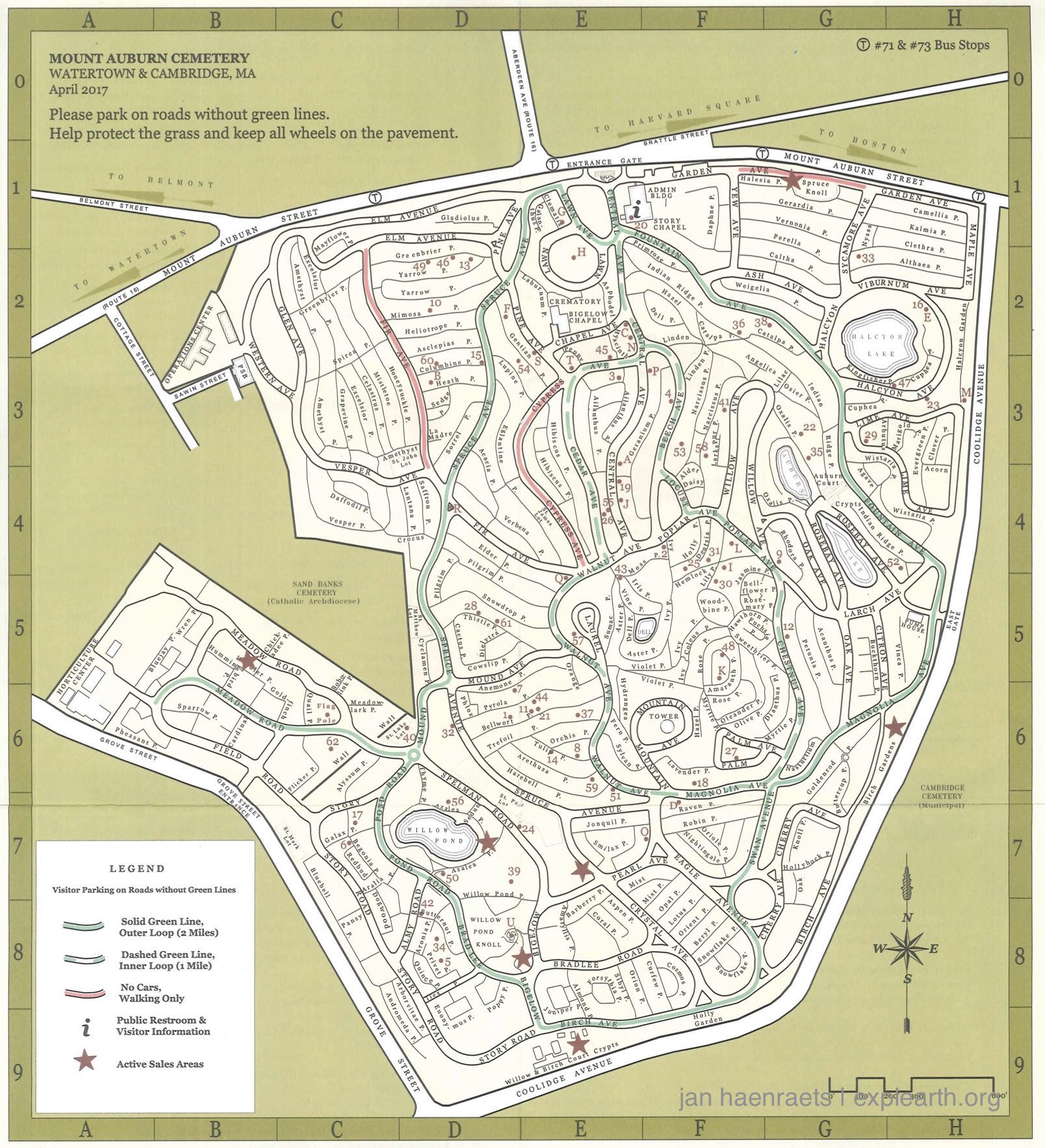Mount Auburn Cemetery
Mount Auburn Cemetery
Important Bird Area Mount Auburn Street Cambridge, Massachusetts 02138
Official WebsiteMount Auburn Cemetery IBA
Mount Auburn Cemetery map
Birds of Interest
Birds of Interest Mount Auburn’s fame as a spring migrant trap is well-earned. Over 170 acres of green nestled in an urban setting beckon coastal migrants to stop to rest and feed, and the numbers and diversity of species can be staggering. Since the beginning of ornithological history in Massachusetts, birders have flocked here to experience this migration, with published records forming a virtually unbroken picture of over a century and a half of spring migration near the coast. While these records are anecdotal at best, it is perhaps the only location in the state where we can track the changes in populations of migrant songbirds.
Some of the more numerous species of warblers observed in spring are Tennessee, Nashville, Yellow, Chestnut-sided, Magnolia, Black-throated Blue, Yellow-rumped, Black-throated Green, Blackburnian, Palm, Bay-breasted, Black-and-white, Canada; American Redstart, Ovenbird, Northern Waterthrush. In addition, Mount Auburn Cemetery is a reliable and nearly annual location for the “semirare” migrants: Gray-cheeked/Bicknell’s Thrush, Cape May Warbler, Worm-eating Warbler, Cerulean Warbler, Kentucky Warbler, Mourning Warbler, Hooded Warbler, and Summer Tanager.
About this Location
Mount Auburn Cemetery is a 175-acre landscaped site of varied topography with four ponds, a renowned horticultural collection, over 20 miles of avenues and paths, and a history of over 170 years as the nation’s first “rural cemetery.” Today, Mount Auburn remains an active cemetery dedicated to its original mission of providing burial and commemoration in a site of natural beauty. The present topography creates a series of well-defined spaces. The site is part of a glacial moraine and includes four ponds and a variety of knolls and dells. The highest elevation is a prominent hill, 125 feet above the Charles River now known as Mount Auburn, that provides a panoramic view of downtown Boston and the surrounding countryside. A network of ponds and wetlands and a mature forest of native pines, oaks, and beeches towering over the surrounding farmland created a special rural character in 1831.
Mount Auburn Cemetery is listed on the National Register of Historic Places, 1975, and it has been nominated as a National Historic Landmark. The horticultural collection includes many species and varieties of non-native plants that contribute to the diversity and interest of the landscape. However, plants identified as “invasive” are being carefully monitored and removed as appropriate. Yellow iris, for example, once edging the ponds, is being removed and replaced with native species. The large number of Norway Maples, planted in the 1930s and 1940s, are being replaced over time with a greater diversity of tree species. Cats do enter the cemetery from nearby neighborhoods, but there is no feral feline population on the grounds. Cowbirds appear to be relatively few. The condition of the water in the ponds is carefully monitored, and the ponds are relatively isolated. Testing of pond water and well water has not indicated any groundwater contamination. Studies of the lichen populations indicate that these species reflect a “typical urban lichen pattern”. The size and location of the site have meant that plant species are growing here in relative isolation from other populations. Nearly a dozen mature American Elms still flourish on the site and are being carefully observed. Close inspections are carried out for Hemlock Woolly Adelgid; individual trees are treated with safe oils and soaps as necessary.
As you explore, remember that this is not your typical park. Please help to preserve Mount Auburn’s character and beauty by being mindful of the visitor guidelines. Biking, running, dog walking, and picnicking are prohibited. There is no visitor parking lot at Mount Auburn. Instead, visitors can park on any road throughout our 175 acres without a green line. Please help to maintain the grass by keeping all four wheels on the road’s surface.
Look for available parking around Asa Gray Garden if you plan to meet a friend near our Entrance or if you will start your visit at the Visitors Center. On busy days, parking around the Garden fills up quickly. We encourage you to drive a bit deeper into the Cemetery, where parking will be easier to find.
Please Note: There is a small parking lot at the Administration Building for those with appointments at our office. Please do not park in these spaces unless you have official office business.
Visitors can find public restrooms at the Administration Building/Story Chapel complex located just inside the Entrance.
Make sure you’ve filled your reusable water bottle before heading to the Cemetery. At present, there is no drinking water for visitors on our grounds. Please do not drink the water from the fixtures found in the landscape as this water is not potable.
The Visitors Center, located in Story Chapel, is staffed daily between 9 am and 4:30 pm. Self-serve visitor materials are also available from the Visitors Center whenever the grounds are open to the public.
Printed maps and other self-guided visitor materials are available whenever the Cemetery is open at the racks at the Entrance Gate. These materials are also available at the Visitors Center when it is open.
Use your smartphone to explore Mount Auburn: Use the Mount Auburn Mobile App to navigate the grounds, search burial records, or follow one of the curated tours to visit points of interest.
Features
Restrooms on site
Wheelchair accessible trail
Roadside viewing
Entrance fee
Content from Official Website and Mount Auburn Cemetery IBA
Last updated January 6, 2024
